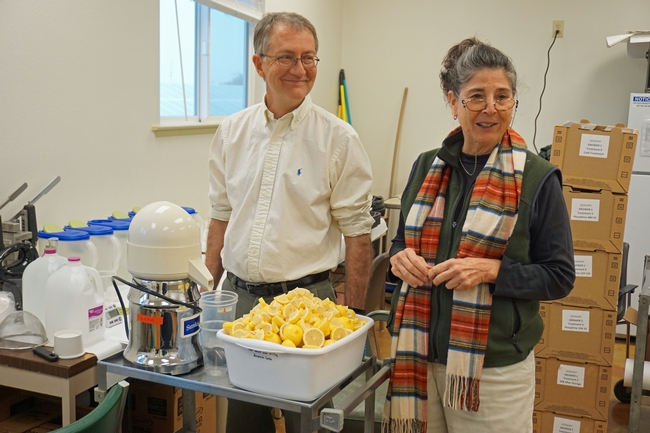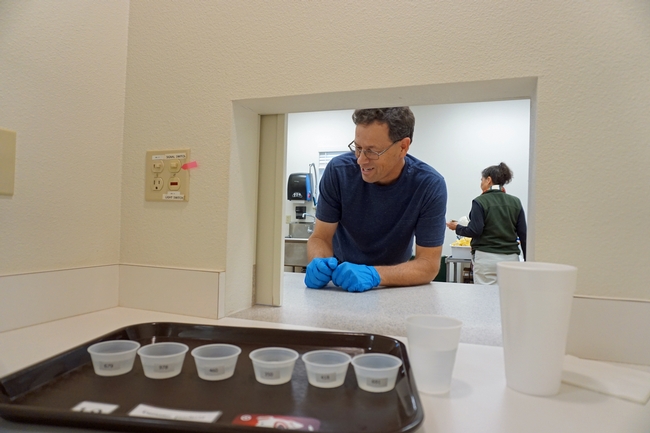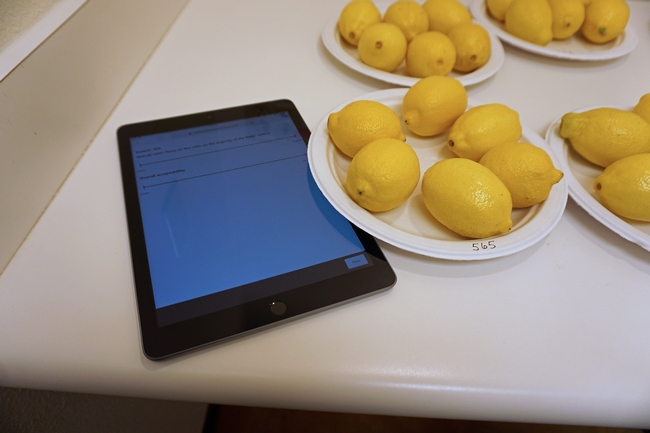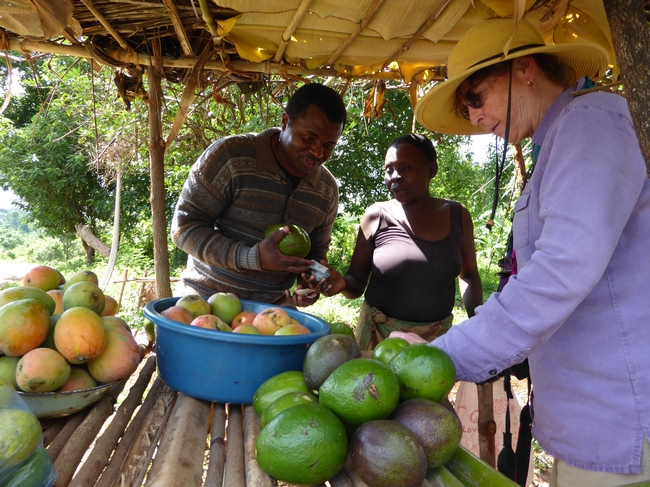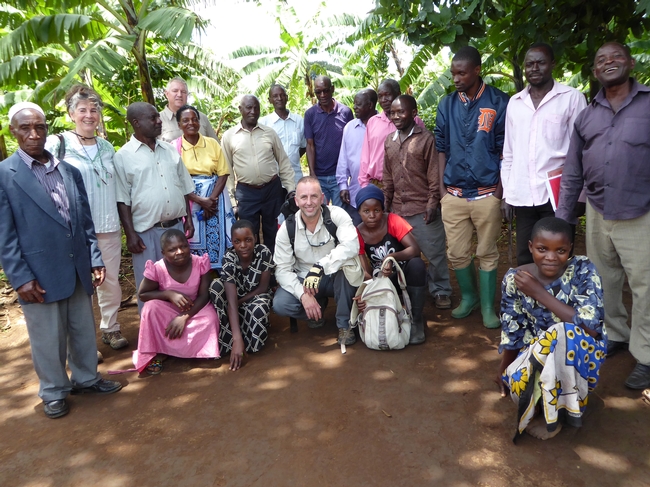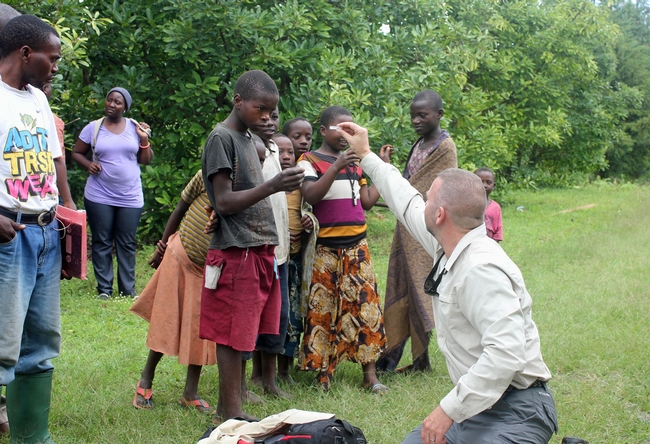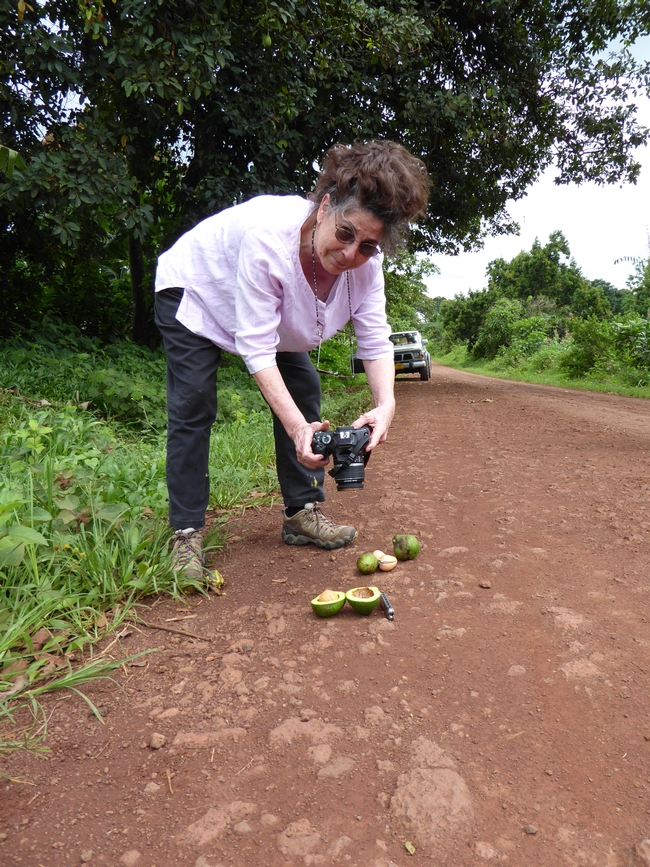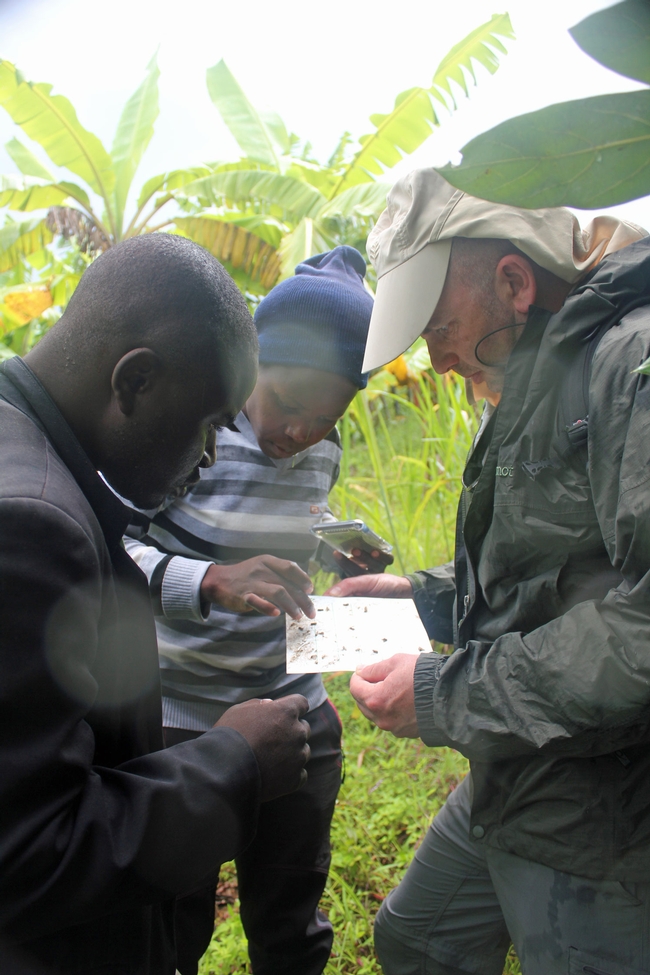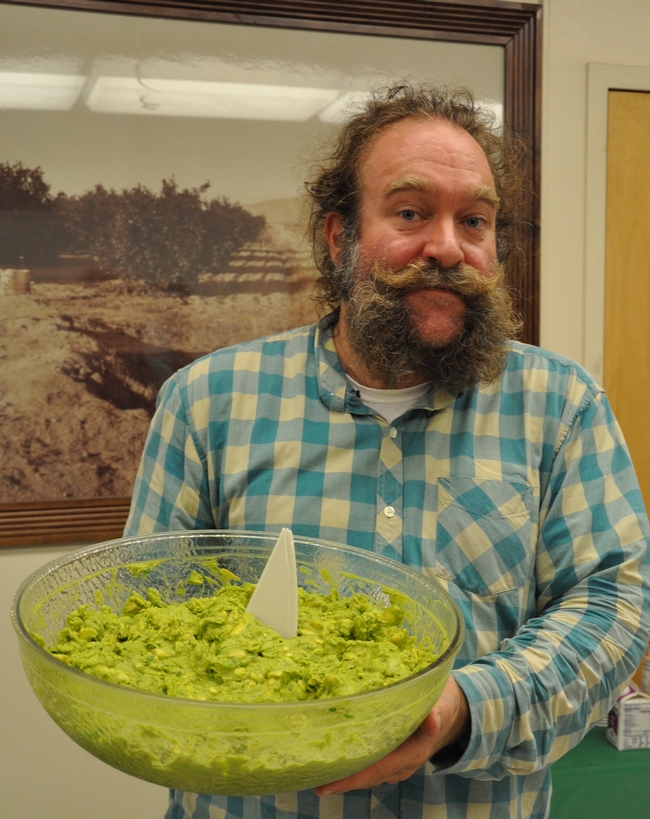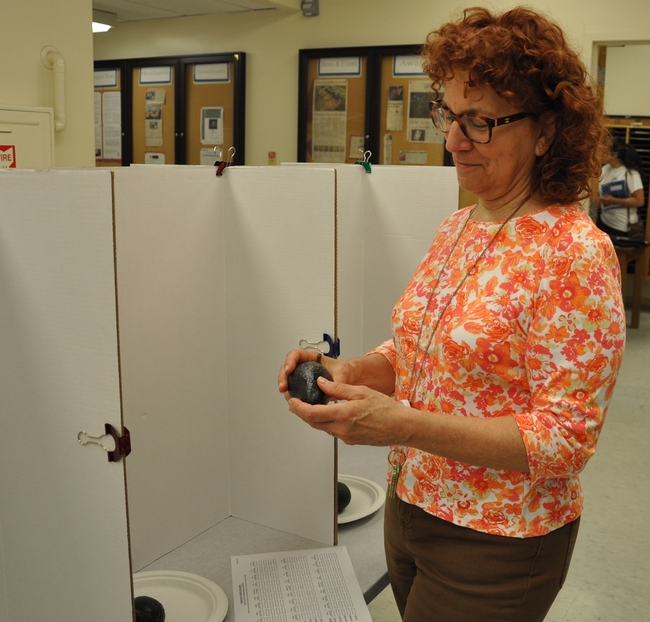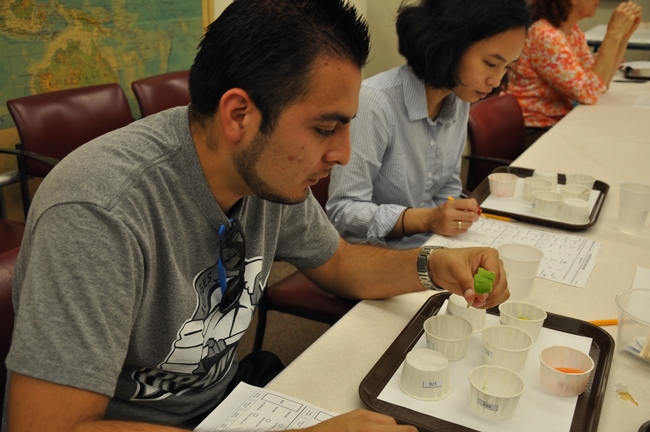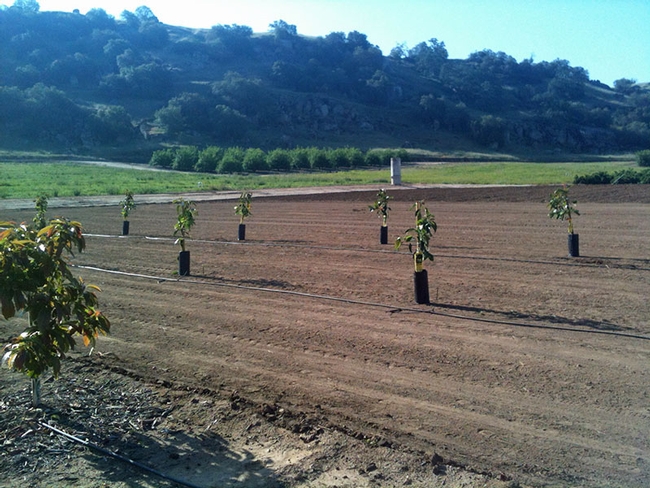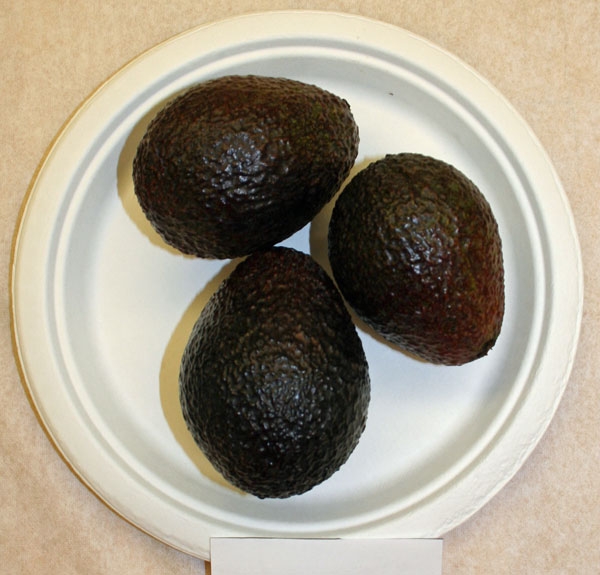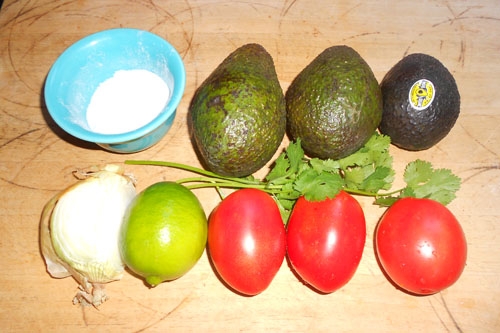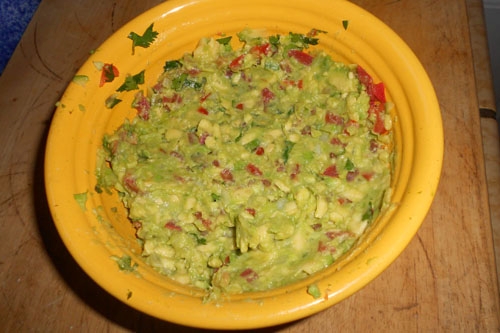Posts Tagged: Mary Lu Arpaia
Lemon water tasting at UC research center kicks off an 18-month citrus sensory study
What flavors do you detect in a sip of lemon water? Are there notes of sweetness, sour, off flavors or fresh citrus taste? Scientists at the UC Kearney Agricultural Research and Extension Center and the USDA want to know every subtle taste sensation for a research project continuing over the next 18 months.
Participants will taste the major types of citrus to confirm that treatments used to eliminate pests in overseas shipments don't have an impact on fruit enjoyment. Lemon tasting will be followed by mandarins, navel and Valencia oranges, and grapefruit.
“This work is critical for the citrus industry,” said Mary Lu Arpaia, UC Cooperative Extension specialist in subtropical fruit. “A huge amount of California citrus is exported, but if there are quarantined pests in the shipment, that triggers treatments with a fumigant.”
In the past, importers treated citrus with methyl bromide. However, the pesticide has been phased out because it depletes the ozone layer. An alternative fumigant, phosphine, kills the insects, but scientists don't yet know what impact the chemical will have on the fruit.
“We're hoping there's no taste difference,” Arpaia said. “But we don't know. That's why we're doing the testing.”
USDA plant physiologist David Obenland, based at the USDA office across the street from Kearney in Parlier, is working with Arpaia to conduct the study at Kearney's sensory laboratory. The 1,100-square-foot laboratory features neutral white paint and broad-spectrum lighting; the ventilation system minimizes distracting odors. Six tasting booths each have small windows that open to the kitchen area, where samples are prepared.
“Previous research has resolved residue issues and determined phosphine is effective in killing the pests,” Obenland said. “But they didn't fully determine whether the process would hurt the fruit.”
The current project compares fruit treated with methyl bromide, phosphine and a cold temperature protocol in which the fruit is held just above freezing for three weeks. In addition to tasting the fruit, volunteers evaluate the fruit's appearance.
“People buy with their eyes,” Arpaia said. “We're asking our participants to compare the fruit visually to see if they detect any differences.”
The research is funded by the California Citrus Quality Council through a grant from the USDA Foreign Agricultural Service.
UC ANR scientists help fledgling Tanzania avocado industry
Dedicated growers and research support from the University of California have made avocados a California success story. As part of the UC Global Food Initiative, which is channeling UC resources toward sustainably feeding the world's growing population, the California avocado experience can help alleviate food insecurity and poverty overseas.
Two UC Cooperative Extension specialists found a way to do that in Tanzania, Africa, where 69 percent of the population live below the poverty line and 16 percent of children under 5 are malnourished. In March 2017, UCCE biocontrol specialist Mark Hoddle and UCCE subtropical crops specialist Mary Lu Arpaia traveled to the east African nation to help growers there with their fledgling avocado industry.
In the late 19th Century, German missionaries introduced avocados to Tanzania when it was colonized by this European nation. Germany lost influence over the African country following World War I, but huge non-commercial avocado trees still thrive in the landscape.
Recently, attempts at commercial production growing the popular Hass variety are gaining momentum.
With proximity to a European market hungry for fresh avocados, Rungwe Avocado Company planted 250 acres of the Hass variety in the southern highlands around Mbeya near Lake Malawi, which establishes the border of south western Tanzania with Zambia and Malawi. In order to grow production to a level that would make the export to Europe practical and to support rural residents with a viable business option, approximately 3,700 small landholder farmers, known as outgrowers, were recruited to grow avocados. They manage small plots with as few as 20 trees to larger acreage with more than 200 trees, with participating farms ranging in elevation from 1,200 to nearly 6,000 feet.
However, this fledgling industry is experiencing production challenges, prompting the company to contact UC Cooperative Extension. UC faculty, specialists and advisors have conducted research on Hass avocados for decades in California and worked closely with growers to extend information that has supported the development of an industry with high-yielding trees producing premium fruit valued at more than $400 million per year.
“One of the aims of the Global Food Initiative is to deploy UC's best research and extension practices to address the key challenge of improving food production,” Arpaia said. “That's why we went to Tanzania.”
Hoddle and Arpaia visited growers, extension technicians, packing house managers and logistics experts. They identified production, pest management and fruit handling challenges faced by the avocado industry.
“The situation in Tanzania is quite different than California, and also different compared to Central and South America, where we have also worked on avocado production issues,” Hoddle said. “But we identified familiar issues that affect management for which there are solutions.”
Hoddle examined the Tanzanian avocado trees and fruit, and collected insect specimens. He said the insect damage was minimal at the time of the week long visit.
“That surprised me because of the insect biodiversity in Africa,” he said. “There was little evidence of heavy leaf feeding. There was some evidence of fruit damage caused by insect feeding on the skin, but they don't seem to have fruit boring weevils or caterpillars that we commonly see in parts of Mexico, Central and South America.”
A critical issue is extending entomological information to the outlying farmers to improve their ability to identify and manage beneficial insects and crop pests.
“They don't have the magnifying loops, collecting vials and insect boxes that we regularly use for insect identification,” Hoddle said. “I showed them my Leatherman tool, which can be used to open up fruit and look for damage. They need these basic tools.”
A post-harvest expert, Arpaia was able to identify ways to improve picking, handling, storage and shipping practices that would result in top quality fruit arrival in Europe.
The two scientists produced a report, which emphasized the need to provide outlying growers with basic equipment and agronomic information.
“We want to help them be better avocado farmers so the crop can be a greater contributor to the country's economy,” Arpaia said. “Boosting this industry will also give people all over Tanzania the opportunity to add nutritious avocados to their diets.”
Have you tasted an avocado lately?
The lab of Mary Lu Arpaia, a Cooperative Extension subtropical horticulturalist with UC Agriculture and Natural Resources (UC ANR) and the Department of Botany and Plant Sciences at UC Riverside, hosts an avocado tasting each month on the UCR campus. Attended typically by about 60 people, the tastings have grown in popularity over the years.
Eric Focht, a staff research associate in the Arpaia lab, helps organize the tastings; the guacamole he prepares specially for the occasion serves as an additional attraction. Focht has been working on avocados since 1999, the year he joined UCR as a staff member. His relationship with the campus, however, began before then; his father, now retired, was a professor on campus.
Typically, participants of the avocado tastings sample six avocados which come from UC ANR's South Coast Research and Extension Center in Irvine. “Hass control fruit are purchased from or donated by a packing house,” Focht says.
First, participants do a visual assessment of the fruit, evaluating texture, size and color. Next they step into a room where they do the blind tastings.
“The data is compiled and used to assess, among other things, which of our new breeding selections shows promise and should be pushed for eventual release,” says Focht, whose duties include coordinating field activities, designing field layouts, generating maps and databases, selecting avocado varieties of interest, interacting with growers and the public, troubleshooting, and directing the day-to-day operations of the lab when Arpaia is away.
Focht's favorite avocado variety varies by year and season.
“Right now our 465518-99 has been performing very well,” he says, “but in former years, its peak season is February through April. In the fall, Reed is always a good fruit with good flavor and texture. I prefer a fruit that peels easily and has good flavor. If it doesn't peel clean from the skin, I tend to overlook it for something else with good flavor and convenient packaging.”
The avocado growing season varies from variety to variety. By planting out several varieties, it is possible to have avocados year round in one's garden. Focht explains that the growing season varies regionally as well.
“The season in San Luis Obispo is months later than it is in San Diego,” he says.
Most avocado acreage in California is currently in Northern San Diego County. Most avocado acreage in the U.S. is in California. Other states with avocado industries include Florida and Texas. Worldwide, avocados are grown in Mexico, Chile, Peru, Israel, Australia, South Africa and New Zealand.
The California drought, now in its fourth year, is a concern for avocado lovers and scholars like Focht.
“An acre of avocado trees typically requires 2.5-4 acre-feet of water per year depending on weather and other factors,” he says. “The drought is resulting in lost acreage as farmers can either not afford or not find enough water for their trees. Successful farmers are having to modify their cultural practices to stay competitive.”
The next avocado tasting at UCR will be Aug. 12, 2015. For more information about the tastings, contact Focht.
Avocado production in the San Joaquin Valley gets closer
The San Joaquin Valley is the heart of California agriculture, but hasn't been a hospitable home for commercial avocado production. UC Cooperative Extension specialist Mary Lu Arpaia is conducting research to change that.
Avocados are native of semi subtropical high elevation rainforests in Mexico and Central America. A delicious and highly nutritious fruit, the cultivation of avocado has spread around the world. In California, growers are having commercial success in areas with year-round mild climates, such as San Diego and Ventura counties.
Though avocados are frost sensitive to be sure, it is not the cold winter climate that is the greatest impediment to avocado production in the state's inland valleys. It's the heat.
“Plant leaves have stomata, small openings that allow water vapor to move out of the plant to cool the leaf surface,” Arpaia said. “It works something like perspiration on people. Moisture exits the pores and cools the skin.”
The stomata on the leaves of Hass avocados – the variety most favored by California consumers – close when the temperature rises above 90 degrees. No moisture is released from the closed stomata and the plant overheats, causing fruit drop.
“To grow avocados in the valley, we need to have a variety that can tolerate heat better than Hass,” Arpaia said.
“The ones that we're testing in the field have eating quality comparable to Hass,” Arpaia said.
Lindcove is situated where the valley floor is gently rising toward the Sierra Nevada. The slope allows cold air to slip down to lower elevations, giving farmers in the area an advantage of a few degrees in the winter. The geography has made the area an important location for citrus production. But heat-tolerant avocados could be an alternative.
East-side citrus farmers may be looking for other options if Huanglongbing (HLB) disease makes its way to the area. Already, the pest that spreads HLB, Asian citrus psyllid, is established in some parts of the valley and spreading. Once a tree is infected with HLB, it cannot be cured.
“Growers have made good money on avocados,” Arpaia said. “In the San Joaquin Valley, water is relatively cheap and we have better water quality than San Diego County. There are good, well-drained soils. Avocados' frost sensitivity is similar to lemons. If farmers have property where they can grow lemons, they could try avocados.”
An initiative to enhance competitive and sustainable food systems is part of the UC Division of Agriculture and Natural Resources Strategic Vision 2025.
Adding variety: avocados and guacamole
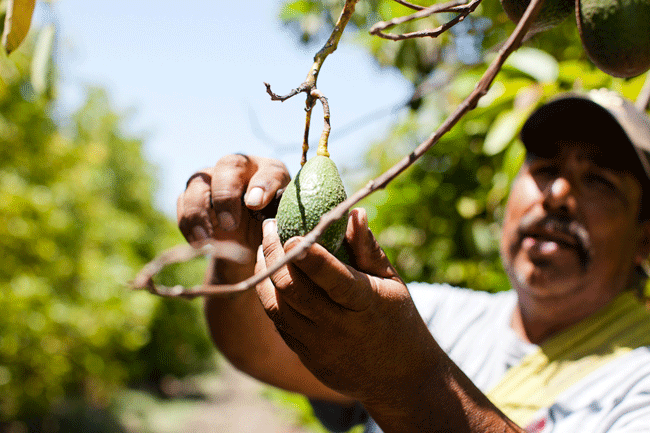
I have limited cooking skills, so I’m lucky that my wife is a great cook and an even better baker – lemon bars, anyone?
But there’s one dish she prefers that I prepare: guacamole. I was thinking about this when I was reviewing our recent photo shoot at UC ANR’s South Coast Research and Extension Center in Irvine, which included images of strawberries, citrus and avocados.
“Our whole goal is to make the industry in California more sustainable,” said UC Cooperative Extension specialist Mary Lu Arpaia, in the Department of Botany and Plant Sciences at UC Riverside.
Arpaia leads UC’s efforts to develop new avocado varieties. The dominant variety, Hass, started in 1926 in Southern California and has become so common globally that it could become generic, Arpaia said.
“My belief is the way we’re going to differentiate ourselves as a California industry and survive is by breeding something unique,” Arpaia said.
UC Riverside has developed several avocado varieties, signing a license agreement last year for its latest release, GEM. The great-granddaughter of the Hass avocado, GEM shares Hass’ desired characteristics such as a creamy, nutty flesh while offering growers additional benefits such as being a smaller tree that typically is more productive, Arpaia said.
Arpaia is evaluating more varieties. The next potential release is likely two to three years away, she said.
Meanwhile, Arpaia also is collaborating with the U.S. Department of Agriculture to improve the postharvest quality of avocados – how packing houses and distribution centers should handle the fruit, for how long and at what temperature.
“People definitely like fruit that is creamy, smooth, nutty and buttery. They like fruit that has a pleasant aftertaste,” said Arpaia, who conducts monthly avocado tasting panels at UC Riverside.
Packed with nearly 20 nutrients including potassium, avocados are an appetizing addition to salads and sandwiches. Arpaia likes them sliced, eaten alone, in a salad or on a warm corn tortilla. Some like them sweet in cheesecake or milkshakes. Of course, they’re best known as the base ingredient in guacamole.
I keep my guacamole simple: avocados (three), white onion (one-third), Roma tomatoes (three), lime (one), cilantro and salt. I start by scooping out the avocado pulp, slicing it into medium chunks and putting it in a bowl, mixing in lime juice. Then I dice the onion and tomatoes (seeded) into fine pieces and toss them in the bowl, followed by chopped cilantro. Next, I mash it up with a spoon, sprinkling on some salt and more lime juice. Test it and then serve.
For a spicier version, add garlic, jalapeños or serranos. The possibilities are plentiful. Just make sure you start with ripe avocados. What’s your favorite guacamole recipe?


